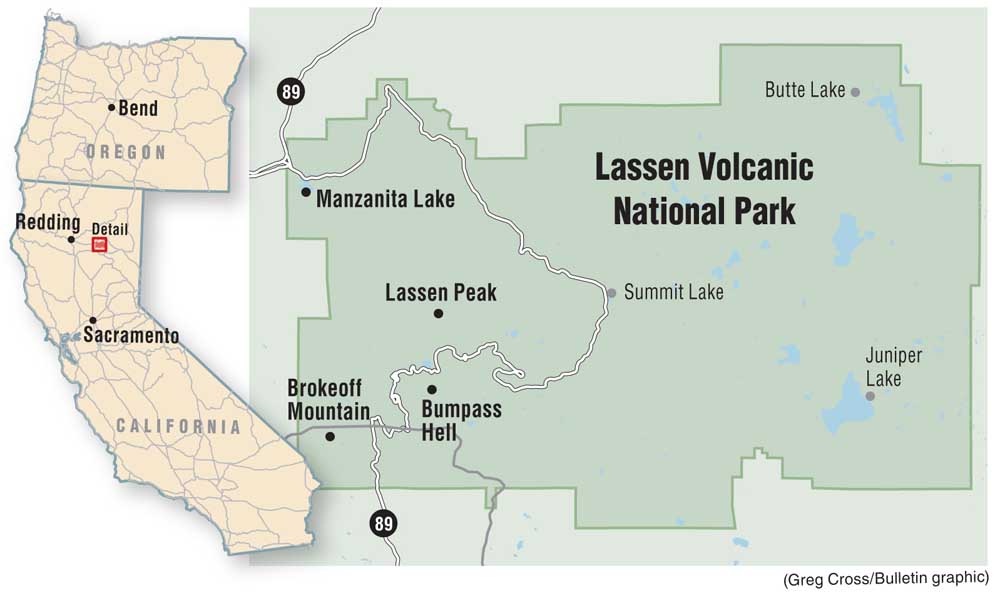Camping and hiking in Northern California’s Lassen Volcanic National Park
Published 7:14 am Thursday, September 14, 2017

- Camping and hiking in Northern California’s Lassen Volcanic National Park
LASSEN VOLCANIC NATIONAL PARK, Calif. —
From the summit of Lassen Peak, we took in the clear blue sky and the surrounding vista of smaller mountains and numerous lakes.
Trending
To the north, a gray wall of smoke from rampant Oregon wildfires was visible.
A recent trip to Lassen provided a chance to escape that smoke, explore this national park that features all four types of volcanoes — shield, cinder cone, plug dome and composite — and a wide range of volcanic activity, including gurgling mud pots, boiling-hot steam vents and the rotten-egg smell of sulfur springs.
Aside from Crater Lake National Park, Lassen is the closest national park to Bend by vehicle. At little more than a five-hour drive, the park makes for an ideal camping and hiking destination over a long weekend.
A friend and I made the drive on a Saturday late last month, and we arrived at Manzanita Lake by late afternoon. Located at the northwest entrance to the park, Manzanita Lake offers a sprawling campground for visitors. We grabbed one of the last remaining campsites, as most sites were already taken by vehicles with California plates. Lassen is a popular destination for travelers from Sacramento and the Bay Area.
After the reminder that a national park during a summer weekend does not provide much solitude, we looked forward to the next morning when we would escape the crowded campground and make the drive through the park to some hiking destinations.
Located at the southwest end of the park, 9,235-foot Brokeoff Mountain is the eroded remnant of a massive composite volcano, Mount Tehama, according to the National Park Service.
Trending
The hike up Brokeoff included 2,600 feet of elevation gained over 7.4 miles. The trail started out through hemlock trees and open wildflower meadows and steadily became steeper and steeper. Above the tree line, we negotiated a series of switchbacks that finally led us to the summit.
From the top, we could see Lassen Peak, Mount Diller and Mount Shasta in the distance on an overcast morning. Below us was the vast caldera of Mount Tehama.
The hike back down was hard on the knees as we negotiated the precipitous trail back into the trees.
The Brokeoff Mountain hike is considered one of the most challenging in Lassen Volcanic National Park, but we still had enough energy that day for a short hike to one of the park’s most visited sites.
According to the park service, Bumpass Hell is named for pioneer Kendall Vanhook Bumpass, who stumbled upon these hot, sulfurous gas features in the 1860s and stepped into a boiling pool and burned his leg.
Today the 3-mile round-trip trail is well-signed to help keep visitors safe. According to the park service, Bumpass Hell is the largest hydrothermal area in the park and features the upflow of steam and discharge from the Lassen hydrothermal system. Big Boiler is the largest fumarole — a vent from which volcanic gas escapes — in the park, and the steam jetting from it has been measured as high as 322 degrees.
The trail into the Bumpass Hell basin and boardwalk is only 1.5 miles and relatively easy, so not surprisingly it is crowded with tourists from all over the world during the summer. A sulfureous smell emanates from the steaming pools, and the thermally active basin is stained orange and yellow by sulfur.
Our last day in the park would include a summit of 10,457-foot Lassen Peak, which rises in the middle of the park above all neighboring peaks and is the southernmost active volcano in the Cascade Range.
According to the park service, Lassen Peak is one of the largest plug dome volcanoes in the world. Its most recent eruptions came between 1914 and 1921 and were the last in the Cascades before Mount St. Helens erupted in 1980.
The hike to the top of Lassen starts at 8,500 feet, so climbers need to gain only about 2,000 feet to reach the summit on afive-mile round-trip trek. The trail is fairly easy, though it gets increasingly steep over switchbacks near the top. A four-year project to restore the 70-year-old Lassen Peak Trail was completed in 2014.
Few trees are located along the route, but even without shade, the high elevation kept the air relatively cool. The trail cut along a rocky ridge as we reached the top, where the peak crater included a lingering smell of sulfur.
The panoramic view stretched for miles in that beautiful spot, where the Cascade Range meets the Sierra Nevada to the south and the Great Basin desert to the east.
The climb to the summit of Lassen was a perfect way to cap the trip to an intriguing, if lesser-known, national park.
— Reporter: 541-383-0318,
mmorical@bendbulletin.com








